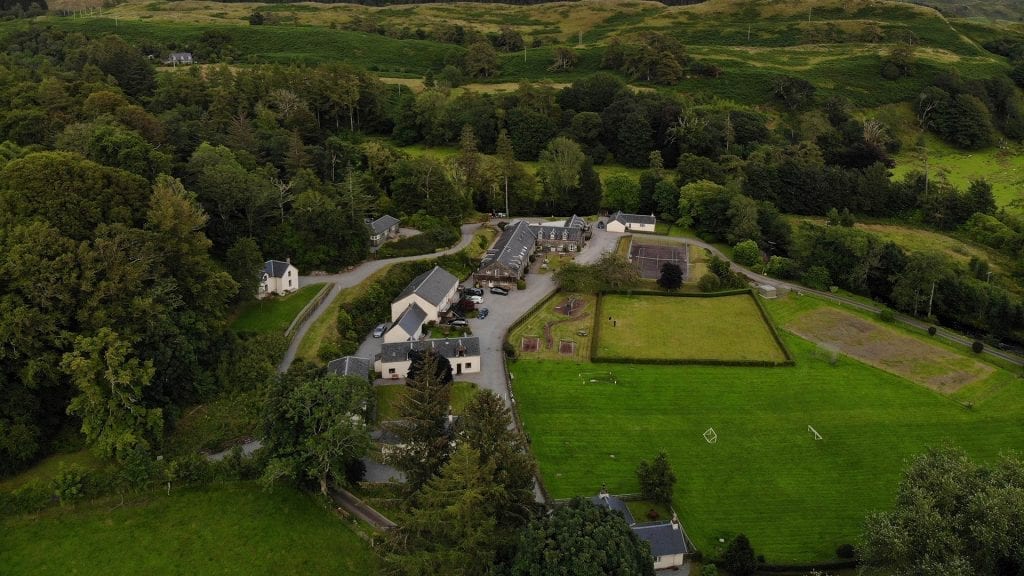History & Heritage
A land of weathered escarpments running south-westwards to end in chains of scattered islets and dark splintered reefs and skerries.

Numerous cairns, Iron-Age forts and dunes provide reminders of an ancient past, whilst several properties on the shores of Loch Melfort bear witness to the domination of the Campbell family in more recent times – Craignish Castle, Arduaine, Melfort, Ardenstur, Kilchoan, Degnish, and Ardmaddy were all at one time or another the property of various Campbell lairds.
The Campbells never had it easy in this “debatable land” and many a marauding band of raiders have left their memorials to these blood-thirsty days, often in the form of funeral cairns or standing stones. In Gillies’ book “Nether Lorn and Its Neighbourhood (1909)” we read of one such example of this: “After his futile attempt upon Craignish Castle, Alexander MacDonald, in his progress northwards invaded Melfort. The Laird, John Campbell, was absent with his retainers in attendance upon Argyll, and his wife, endeavouring to appease the fierce enemies of her Clan, gave orders to have a sumptuous repast laid in the mansion house, then at Ardenstur, for their entertainment while she and all the inhabitants hid themselves in the woods and mountain retreats. The hostile army, having arrived at the house, regaled themselves with the food andd drink provided and being in high good humour, MacDonald issued strict injunctions to his men not to meddle with any of Melfort’s property. Shortly after leaving and as he ascended the pass over into the neighbouring district of Kilninver, he noticed the house in flames. In great fury he caused enquiry to be made and hanged three Irishmen who were found guilty upon a gallows erected upon the summit of the hill known as Kenmore at a place called Toma-Chrochaidh (The Mound of Hanging).”

The Melfort Campbells during their last 130 years had a most distinguished record in the civil and military services. During that period the descendants of Captain Archibald Campbell of Melfort who died in 1773 and his wife Annabel, daughter of Campbell of Barcaldine, gave for the service of their country two admirals, one captain RN, one commander RN, four generals, four colonels, two majors, six captains, and six lieutenants. Harrison Ainsley and Co. purchased the estate in 1838 as an ideal location for the manufacture of gunpowder. Not only is it secluded, but it has a deep water pier and plentiful supplies of scrub oak.
Read more about the Clan Campbell History >

The village and lands of Melfort, in Campbell ownership since the 14th century, were purchased by an English gunpowder company, Harrison Ainslie & Co in 1838 as an ideal location for the manufacture of gunpowder. Not only was it secluded, but it had plentiful supplies of scrub oak and a deep water pier for deliveries of raw materials and export of gunpowder.
To understand the advantage of these features, one needs to have a quick look at the actual manufacture of black powder as it was practised at Melfort. The first stage was preparing the raw materials by refining the salt-petre and sulphur, manufacturing the charcoal from the oak scrub, pulverising the ingredients separately and mixing them in required proportions. The gunpowder was then incorporated by mechanically grinding and crushing the ingredients into an intimate mixture. At this stage the gunpowder was in the form of a damp paste known as millcake. This was pressed in hard slate-like sheets of press cake corned or formed into grains of various sizes, dusted, glazed and finally dried. Charcoal was the variable factor in the composition and its preparation involved selection of the wood to be used and control of the burning process. The traditional method of charring wood in stacks made excellent charcoal for the fuel but the product was too impure and uneven as an ingredient of gunpowder.
A new method of distilling wood in sealed retorts was therefore developed in the late 18th century. Coppices were planted around powder mills to supply the necessary wood. Salt-petre in the form of fine crystals could be used straight from the refinery but the charcoal and sulphur had to be pulverised. This was done traditionally in crushing mills with stone-edged runners rolling upon a circular bedstone and in the 19th century machines similar to giant coffee grinders were introduced for pulverising charcoal. The powdered ingredients were each sieved to ensure uniformity to remove any gritty particles which might cause an explosion during manufacture. The saltpetre, charcoal and sulphur were then weighed out normally in the proportions of 75/15/10 and mixed in a revolving drum to produce the green charge for the incorporating mills.
Incorporating mills with stone-edged runners were introduced in Britain in the early 18th century. The charge was moistened and kept damp throughout theincorporating process which lasted for about 2 hours for common blasting powder, and 8 hours or more for the finest sporting grades. Production was continuous with the workforce operating a shift system.
In the 19th century steam engines and later water turbines were introduced to drive incorporating mills and other equipment, the remnants of which are still evident at Melfort. Improvements were made in the design and this enabled a larger charge to be processed. Pressing the millcake to increase its specific gravity was introduced in the 18th century. Granulating machines with toothed rollers cut the press cake into pieces. After it was corned, the remaining dust was removed by tumbling the powder in gauze-covered revolving cylinders. The powder was dried normally by heating of steam pipes and traditionally packed in oak barrels and kegs of various sizes. Most powder mills had their own cooperage and this employed a large proportion of the workforce.
For transport within factories, punts were used on mill streams wherever possible and tramways were laid to connect the different buildings, with the trams pulled by horses or pushed by workmen. Gunpowder was stored in factory magazines while awaiting despatch. There was a considerable coastal traffic in gunpowder for which the Government and several private firms like Harrison and Ainsley maintained their own fleets of sailing barges.
Minor accidents were commonplace and most mills would experience a fatal explosion occasionally. At Melfort in 1867 for example, an explosion took place resulting in the total destruction of the powder works as recorded in the”Oban Times” of 9 March. This article tells of a bale of cloth being thrown from the last building to a distance of about a mile. Many of the windows in the houses were smashed by the concussion of air.

By the middle of the 19th century, steamboats were well established on routes all along the West Coast and around the islands.
The Pier is one of many such deep water piers on Loch Melfort, each serving a separate village or large Estate. Similar piers exist at Arduaine, Isle of Shuna , Lunga & Toberonochy, all of which would have been serviced by the same ships with their vital supplies.
Loch Melfort was deep enough for large vessels to carry out deliveries of raw materials involved in the manufacture of gunpowder at nearby Melfort Estate and to collect the finished product for distribution around the country. A tram-way connected the Pier with the gunpowder works east of Melfort House in addition to the road, which, until the early 20th century was nothing more than a cart track.
In recent years, Melfort Pier has been used for leisure-based activities – yachting, wind-surfing and fishing.

Inevitably automation and the development of dynamite brought about the decline of the works. Gunpowder production continued until the late 19th century when the estate was sold for farming purposes. Farming continued well into the 1970′s when the ‘semi-resident’ owner began to offer the old farm-workers’ cottages for self-catering holidays.
In 1982, the Melfort Estate was offered for sale and the part now known as Melfort Village was purchased by Charles and Helen Stott who had discovered the location whilst on a sailing holiday. Their vision of Melfort was to create a Cottage Membership village where people could own, ‘a week in Argyll forever for less than a week in Argyll’. Gradually, over a period of 7 years, 32 cottages were built from the ruins of the gunpowder village and farm buildings, developed by the Stotts’ company, Loch Melfort Estate Ltd.
By the end of 1992, Melfort was almost fully sold out. Charles Stott then put his house and grounds on the market and sold his interests in Melfort Village to The Melfort Club.
Now over a century later and housed in the old buildings Melfort Village flourishes. The names of the cottages reflect their function within the framework of the old gunpowder village. The ruins and the lade along the banks of the River Oude along with certain remnants of the tramway which ran from the village to the pier at Fearnach Bay complete the picture. The very existence of the Melfort Club in its present form ensures that the illustrious history and the uniqueness of the Melfort village will be preserved for many generations to come.
Notwithstanding all the changes seen, today Melfort Village is one of the most successful Cottage Membership operations in Scotland, probably the UK. It is owned and managed by The Melfort Club, being the Association of Melfort owners, and was formed in 1983. Each cottage owner has a direct say in the way the Village is run, through a professionally qualified Committee elected from the membership. The Club has approximately 1200 members owning a total of 1600 holiday weeks, who contribute annually to its maintenance as a high amenity holiday venue. Every week in each cottage has an owner, although they can choose whether or not to use their week each year. This means that we also have rental guests and guests using the RCI and 7Across exchange systems.
Sources
1. Gillies – Nether Lorn 1909
2. Islands of Nether Lorn – West Highland Series No 3
3. Glenys Crocker – The Gunpowder Industry
ENQUIRIES
Tel: +44 (0)1852 200 257
Email: rentals@melfortvillage.co.ukOUR ADDRESS
Melfort Village
Kilmelford,
Nr Oban,
Argyll,
PA34 4XDNEWSLETTER SIGNUP
[ctct form=”3090″ show_title=”false”]
FOLLOW US

